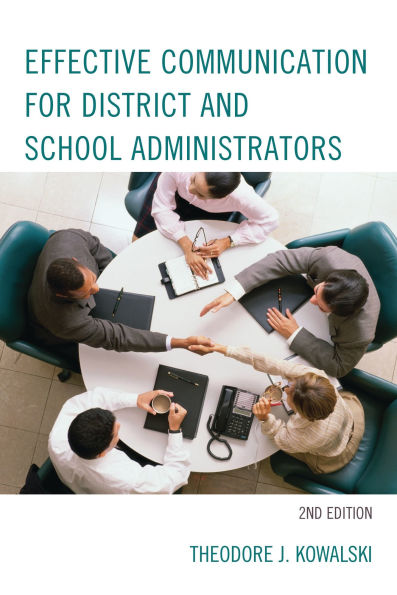Ted Kowalski's book on communication has long set the standard in the field, and this newly updated edition should continue that tradition for years to come. It is clearly organized and crisply written, comprehensive without being encyclopedic. Given the profound changes in the way our schools and society have evolved in the last decade, this book is as timely as it is useful.
The 2nd edition of Effective Communication for School Administrators is unique in that it applies communication perspectives to school tax referendum campaigns, media relations, social media, partnerships and conflict management. The author also offers crucial insights into the ongoing process of educational reform, clarifies its dilemmas and presents possibilities for improving outcomes through excellent communication. The highly relevant material, syntheses and reflective questions make this book indispensable to veteran and aspiring leaders focused on making systemic, long-term changes in their organizations.
In this time of an information saturated society, effective communication is essential for all school leaders. This book considers not only the basics of communication but also how communication affects relationships, organizations, partnerships, and school reform. While this text is grounded in research, Kowalski squarely addresses communication within the context of practice for school leaders, including issues of media relations, social media, conflict resolution, organizational climate, and tax referendum campaigns.
Communication has always been important to organizational life. Advents in electronic communication, adaptive leadership styles, and organizational structure increase needs for effective and efficient communication. This text conveys the essence of communication as it relates to conventional and emergent organizational needs.
Communication has always been important to organizational life. Advents in electronic communication, adaptive leadership styles, and organizational structure increase needs for effective and efficient communication. This text conveys the essence of communication as it relates to conventional and emergent organizational needs.--Scott R. Sweetland, MBA, PhD, educational administration program chair, The Ohio State University
In this time of an information saturated society, effective communication is essential for all school leaders. This book considers not only the basics of communication but also how communication affects relationships, organizations, partnerships, and school reform. While this text is grounded in research, Kowalski squarely addresses communication within the context of practice for school leaders, including issues of media relations, social media, conflict resolution, organizational climate, and tax referendum campaigns.--Patti L. Chance, PhD, professor emerita, department of educational leadership, San Diego State University
Ted Kowalski's book on communication has long set the standard in the field, and this newly updated edition should continue that tradition for years to come. It is clearly organized and crisply written, comprehensive without being encyclopedic. Given the profound changes in the way our schools and society have evolved in the last decade, this book is as timely as it is useful.--George Perreault, PhD, professor, department of educational leadership, University of Nevada, Reno
The 2nd edition of Effective Communication for School Administrators is unique in that it applies communication perspectives to school tax referendum campaigns, media relations, social media, partnerships and conflict management. The author also offers crucial insights into the ongoing process of educational reform, clarifies its dilemmas and presents possibilities for improving outcomes through excellent communication. The highly relevant material, syntheses and reflective questions make this book indispensable to veteran and aspiring leaders focused on making systemic, long-term changes in their organizations.
--Lars G. Björk, PhD, professor, department of educational leadership studies, University of Kentucky
The 2nd edition of Effective Communication for School Administrators is unique in that it applies communication perspectives to school tax referendum campaigns, media relations, social media, partnerships and conflict management. The author also offers crucial insights into the ongoing process of educational reform, clarifies its dilemmas and presents possibilities for improving outcomes through excellent communication. The highly relevant material, syntheses and reflective questions make this book indispensable to veteran and aspiring leaders focused on making systemic, long-term changes in their organizations.



